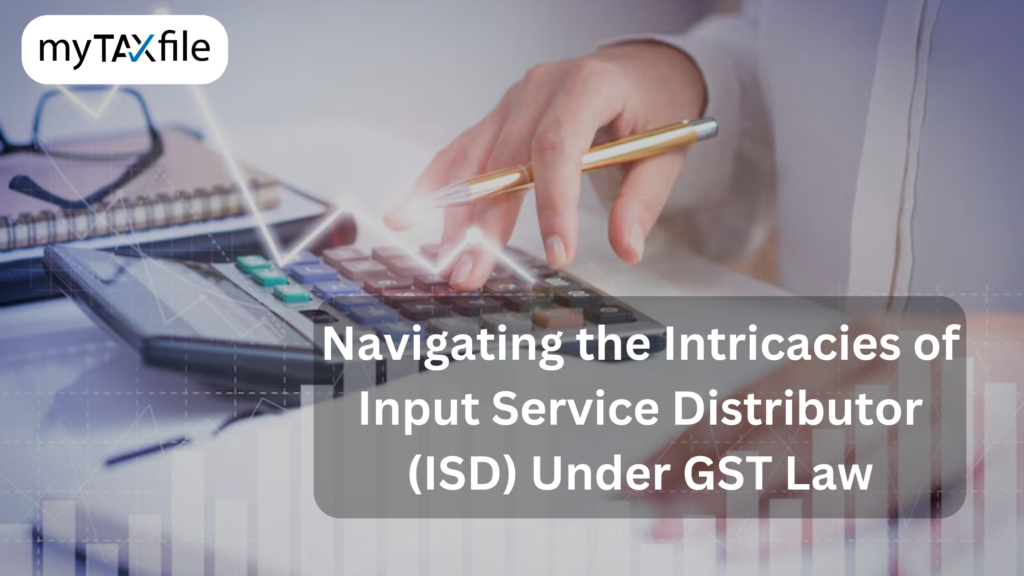In a decisive step toward overhauling one of the country’s oldest and most complex legislative frameworks, the Union Cabinet approved the New Income Tax Bill on February 7, 2025. This landmark reform is set to replace the Income Tax Act of 1961—a statute that has governed direct taxation for over six decades—with a modernized, simplified, and more transparent framework. As the bill prepares to be tabled in Parliament, experts, businesses, and taxpayers alike are keenly watching its potential to transform the way taxes are levied, collected, and enforced in India.
Introduction The Significance of the ISD Mechanism
Under GST, seamless flow of ITC is important to avoid cascading taxes and ensure that businesses are not unduly burdened. However, when a company operates multiple branches or divisions under a single PAN but with different GSTINs, the question of how to apportion or distribute the credit from common input services arises. The ISD mechanism is designed to address this challenge by acting as a centralized office that receives invoices for common input services and distributes the available ITC to all eligible units of the organization. This not only simplifies ITC management but also helps in maintaining uniformity in compliance across the organization.
With recent amendments, notably in the Finance Bill 2025 and Finance Act 2024, the statutory framework governing ISD has become even more robust, ensuring that ITC is distributed accurately, especially for inter-state supplies and reverse charge transactions. Keywords like Input Service Distributor, GST amendments, ITC distribution, and GST compliance are now central to the conversation among tax professionals and businesses alike.
In Simple words, An ISD is a registered entity (usually a head office) that receives invoices for common input services (e.g., legal fees, software licenses) used by its branches. It distributes the ITC proportionally to eligible branches (with the same PAN) via ISD invoices 410.
Example:
M/s ABC Ltd.’s head office in Bangalore receives an invoice for IT services used by its Chennai, Mumbai, and Kolkata branches. As an ISD, it distributes the ITC to these branches based on their turnover 4
Understanding the Concept What Is an Input Service Distributor (ISD)?
Definition and Purpose
An Input Service Distributor (ISD) is defined under Section 2(61) of the CGST Act, 2017. Essentially, an ISD is an office (Centralized All Unit Office) of the supplier of goods or services that receives tax invoices related to input services for or on behalf of distinct persons (branches or units) registered under the same PAN. The primary purpose of an ISD is to consolidate invoices for common input services and then distribute the input tax credit to the individual units in a prescribed manner.
For example, consider a company with its head office in Bangalore and branches in Chennai, Mumbai, and Kolkata. The head office incurs expenses for software maintenance services used by all branches. Instead of claiming the entire ITC at the head office, the ISD mechanism requires that the available credit be proportionately distributed to each branch. This not only ensures proper credit utilization but also prevents the misallocation of tax benefits.
Key Benefits of ISD:
- Centralized ITC Management: Streamlines the process of receiving and distributing ITC.
- Uniform Compliance: Ensures that all branches operating under the same PAN are on the same compliance page.
- Enhanced Transparency: Reduces the risk of errors and fraudulent claims by establishing a clear audit trail.
Historical Evolution: From Service Tax to GST
Before GST, the service tax regime already had mechanisms to address credit distribution, but these were often riddled with complexities and limited to certain types of transactions. With GST’s introduction in 2017, the idea of ISD was refined and extended to accommodate a broader range of services—including those subjects to reverse charge mechanism (RCM). Over time, stakeholders identified areas where the statutory framework needed updating, prompting the GST Council to recommend amendments in subsequent Finance Bills.
The evolution from the earlier regime to the current GST framework represents a significant leap in simplifying tax administration, reducing compliance burdens, and ensuring that ITC flows seamlessly to the rightful recipients.
Registration, Invoicing, and Return Filing for ISD
Registration as an ISD
Regardless of whether a business is already registered under GST, the ISD mechanism mandates a separate registration. When a taxpayer opts to function as an ISD, they must indicate this on the GST REG-01 form (typically in Serial Number 14). This separate registration is crucial because it differentiates the ISD office from the regular business operations that claim ITC directly.
Invoicing and Documentation
An ISD must issue a special ISD invoice that contains:
- The name, address, and GSTIN of both the ISD and the recipient unit.
- A unique serial number.
- The date of issuance.
- The precise amount of ITC being distributed.
- The authorized signature.
If the distribution of credit needs to be adjusted (for instance, due to a subsequent issuance of a credit or debit note), the ISD must also issue an ISD credit note, or debit note accordingly.
Return Filing
Every month, an ISD is required to file Form GSTR-6 by the 13th day of the succeeding month. This form details:
- The total ITC received.
- The ISD invoices issued.
- ISD credit or debit notes that reflect adjustments to the ITC distribution.
The information provided in GSTR-6 is auto-populated into the recipient unit’s GSTR-6A, enabling them to claim the distributed ITC in their monthly returns.
2025 Amendments A Game-Changer for ISD Compliance
The Finance Bill 2025 and Notification No. 16/2024-CT introduced sweeping changes:
- Mandatory ISD Registration:
Businesses with multi-state GSTINs must now register as ISD to distribute common ITC. Cross-charge invoices are no longer valid for credit distribution.- Penalty: Non-compliance attracts penalties under Sections 122 and 125 of the CGST Act
- Penalty: Non-compliance attracts penalties under Sections 122 and 125 of the CGST Act
- Inclusion of Reverse Charge Mechanism (RCM):
ISDs can now distribute ITC for inter-state supplies where tax is paid under RCM (Sections 5(3) and 5(4) of the IGST Act) - Clarity on ITC Distribution Formula:
ITC must be allocated based on the proportionate turnover of operational branches:
C1 = C × (T1 / T)
Where:
C1 = ITC distributed to a branch
C = Total ITC available
T1 = Branch turnover
T = Total turnover of all eligible branches - Retrospective Amendments:
- ITC disallowed for construction of plant and machinery (overruling the Safari Retreats case)
- Clarification on SEZ supplies: Goods warehoused in SEZs before export/DTA clearance are non-taxable
The Distribution Process Detailed Illustration
To better understand how ITC is distributed via the ISD mechanism, consider the following hypothetical example:
Illustrative Example:
Scenario:
XYZ Ltd. has its head office in Mumbai (registered as an ISD) and operates branches in Chennai, Pune, and Kolkata. The head office receives a consolidated invoice for software maintenance services amounting to ₹2,00,000 plus GST. The invoice is issued in the name of the head office, which then needs to distribute the ITC among the branches based on their individual turnovers.
Step 1: Determining Total Available Credit
Assume the GST paid on the invoice is:
- CGST: ₹10,000
- SGST: ₹10,000
- Total ITC available: ₹20,000
Step 2: Turnover Data
The monthly turnover of the branches is as follows:
- Chennai: ₹50,00,000
- Pune: ₹80,00,000
- Kolkata: ₹70,00,000
- Total turnover of operational branches = ₹2,00,00,000
Step 3: Pro Rata Distribution Formula
The credit to be allocated to a branch is calculated as:
Credit for Branch=(Branch Turnover/Total Turnover) X Total ITC
Calculations:
- Chennai:
(50 Lakhs/200 Lakhs) X 20000 = 5,000
(₹5,000 each as CGST and SGST would be calculated separately if needed.) - Pune:
(80 Lakhs/200 Lakhs) X 20000 = 8,000 - Kolkata:
(70 Lakhs/200 Lakhs) X 20000 = 7,000
Thus, the ISD in Mumbai will issue ISD invoices to Chennai, Pune, and Kolkata for ₹5,000, ₹8,000, and ₹7,000 respectively, ensuring that the total ITC distributed equals ₹20,000.
This example demonstrates the importance of accurate turnover data and the use of a pro rata formula to ensure fairness in ITC distribution
Landmark Case Laws and Their Implications
Over the past few years, several case laws have shaped the interpretation and application of the ISD provisions. Let’s explore two notable cases that provide clarity on ITC distribution and the responsibilities of an ISD.
Case Law 1: Chief Commissioner of CGST v. M/s. Safari Retreats Private Limited & Ors
In this landmark decision, the Hon’ble Supreme Court held that GST credit cannot be denied solely on the basis that the credit was distributed through an ISD. The case centered on the interpretation of Section 17(5)(d) of the CGST Act, where the Court clarified that the term “plant” must be read in conjunction with “machinery” to ensure that businesses are not unfairly penalized.
Key Takeaways:
- Uniform Interpretation: The ruling emphasized that the technical wording in the statute should not result in denying ITC that is rightfully available.
- Impact on ISD: For ISDs, this means that the distribution of ITC must adhere to a consistent interpretation of eligibility, thereby minimizing disputes during audits.
- Compliance Assurance: Businesses are assured that when they distribute ITC in accordance with the prescribed guidelines, they are compliant with GST Law.
This decision has been widely cited by tax practitioners to advocate for clarity in ITC distribution, reinforcing the role of ISD as a mechanism for fair credit allocation.
Case Law 1: Chief Commissioner of CGST v. M/s. Safari Retreats Private Limited & Ors
A recent ruling by the Hon’ble Bombay High Court further clarified that a taxpayer is entitled to claim ITC on GST paid on advance payments made to a contractor—even before the actual service is received. Although this case did not deal with ISD directly, it has significant implications for ITC distribution.
Key Points from the Ruling:
- Advance Payment ITC: The Court held that ITC is available on GST paid in advance, provided the conditions of Section 16 are met.
- Relevance for ISD: When an ISD receives invoices on advance payments, the same principles apply for distributing the credit among various branches.
- Documentation and Compliance: The decision highlights the need for proper documentation and timely distribution of credit, which are core aspects of the ISD process.
This ruling has set a benchmark for handling ITC on advance payments and is frequently referenced in discussions on ISD compliance.
Detailed Illustrations with Hypothetical Scenarios
To further cement the concept, let’s look at a more comprehensive scenario that demonstrates the interplay between ISD registration, invoice issuance, and ITC distribution:
Comprehensive Hypothetical Scenario:
Scenario Overview:
ABC Enterprises, a large conglomerate, has its head office registered as an ISD in Delhi. It has branches in Mumbai, Bangalore, and Hyderabad. The head office receives a consolidated invoice for outsourced IT services (e.g., digital marketing, consultancy) amounting to ₹5,00,000 plus GST from a service provider. The GST components are:
- CGST: ₹25,000
- SGST: ₹25,000
Total ITC available = ₹50,000
Step 1: ISD Registration and Documentation
ABC Enterprises ensures that its Delhi office has separately registered as an ISD. On receiving the invoice, the Delhi office records the details and prepares to issue ISD invoices to the respective branches. Detailed documentation is maintained to support the credit distribution.
Step 2: Allocation Based on Turnover
Assume the monthly turnovers (relevant for ITC distribution) for the branches are:
- Mumbai: ₹1,20,00,000
- Bangalore: ₹80,00,000
- Hyderabad: ₹1,00,00,000
Total turnover = ₹3,00,00,000
Using the pro rata formula for each branch:
- Mumbai:
ITC = (120 Lakhs/300 Lakhs) X 50000 = 20,000 - Bangalore:
ITC = (80 Lakhs/300 Lakhs) X 50000 = 13,333 - Hyderabad:
ITC = (100 Lakhs/300 Lakhs) X 50000 = 16,667
Step 3: Issuance of ISD Invoices and Return Filing
The Delhi office issues ISD invoices to each branch reflecting their allocated ITC. For instance:
- Mumbai branch receives an ISD invoice showing ₹20,000 ITC.
- Bangalore and Hyderabad branches receive invoices showing approximately ₹13,333 and ₹16,667 ITC, respectively.
Within the same month, the Delhi office files Form GSTR-6 with these details. Consequently, each branch’s GSTR-6A gets updated, allowing them to claim their respective ITC in their GSTR-3B filings.
Step 3: Issuance of ISD Invoices and Return Filing
Suppose a discrepancy is found in the invoice from the service provider—a subsequent credit note reduces the ITC by ₹5,000. The Delhi office then issues an ISD credit note, recalculating the allocation proportionately among the branches. The revised credit distribution is updated in the subsequent return filings, ensuring that the total ITC remains accurate and reconciled.
This comprehensive illustration underscores the importance of:
- Timely and Accurate Documentation: Proper records facilitate smooth distribution and reconciliation.
- Pro Rata Allocation: Ensuring that each branch receives credit in proportion to its contribution (turnover).
- Regulatory Compliance: Adherence to deadlines (GSTR-6 filing by the 13th of the succeeding month) and maintaining a robust audit trail are paramount.
Conclusion
The Input Service Distributor mechanism is a cornerstone of the GST regime, enabling efficient and fair distribution of ITC across multiple branches of a business operating under the same PAN. With recent amendments introduced in the Finance Bills of 2024 and 2025, the provisions governing ISD have become clearer and more robust, particularly concerning reverse charge supplies and the pro rata allocation of ITC.
Landmark case laws, such as the Supreme Court’s ruling in Chief Commissioner of CGST v. M/s. Safari Retreats Private Limited & Ors, and clarifications from the Bombay High Court, underscore the judiciary’s commitment to ensuring that businesses receive their rightful ITC when proper procedures are followed. These decisions, along with detailed illustrations, provide valuable guidance to taxpayers navigating the complexities of ITC distribution under the ISD framework.
As the GST landscape continues to evolve, businesses must invest in robust compliance systems, accurate documentation, and regular training for their finance teams. Embracing these best practices will not only ensure seamless ITC distribution but also safeguard against potential disputes with tax authorities. In the dynamic world of GST, an informed and proactive approach to ISD compliance can serve as a competitive advantage—helping businesses to optimize cash flows and maintain transparency in their tax operations.












